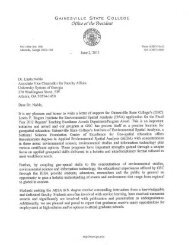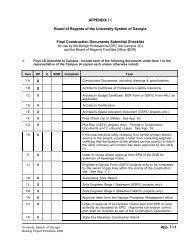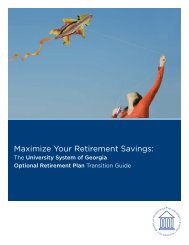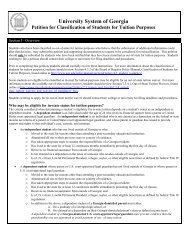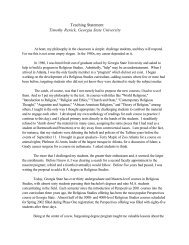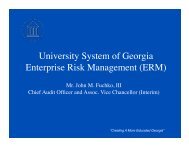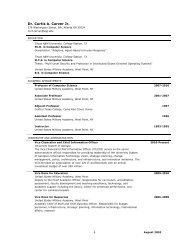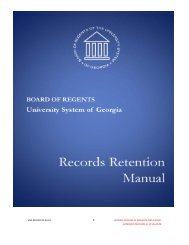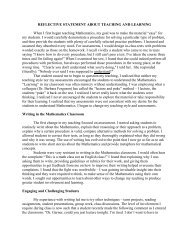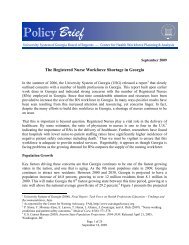WReier-Aviles on DSKGBLS3C1PROD with RULES266898 Federal Register / Vol. 75, No. 209 / Friday, October 29, 2010 / Rules and Regulationsperiod in determining a withdrawal datefor a student. For students in attendanceat the end <strong>of</strong> that limited period, if theinstitution is not required to takeattendance and does not require itsfaculty to do so, then the guidelines fordetermining a withdrawal date for aninstitution that is not required to takeattendance would apply. The<strong>Department</strong> continues to believe that thebest data available should be used indetermining a student’s withdrawal datefrom classes, and, accordingly, if aninstitution requires the taking <strong>of</strong>attendance or is required to takeattendance for any limited period, thenthose records must be used.Lastly, we disagree with the commentthat an outside entity should not be ableto require an institution to takeattendance. We continue to believe thatour policy that an ‘‘institution that isrequired to take attendance’’ means aninstitution that is required to takeattendance by an outside entity is areasonable interpretation <strong>of</strong> the statute.The phrase ‘‘required to takeattendance’’ presupposes that an entityhas this requirement, and under thisregulation, that entity may be either theinstitution itself or a separate entity.Changes: None.Comment: A few commentersexpressed concern about who woulddecide what ‘‘required to takeattendance means.’’ Specifically, theywere concerned that the <strong>Department</strong>would determine that an institution oroutside entity had a requirement thatattendance be taken at an institution,even if the institution or outside entitydisagreed with that conclusion. Thecommenters believed that the entityrequiring the taking <strong>of</strong> attendanceshould make the determination aboutwhen attendance must be taken andwhat kind <strong>of</strong> documentation to supportattendance taking is necessary, and thatthe <strong>Department</strong> should not superimposeits view <strong>of</strong> attendance taking on thatentity. In particular, a few commentersopposed the idea that the <strong>Department</strong>would consider clock-hour institutionsto be institutions required to takeattendance if an outside entity or theinstitutions themselves did not believethat they were. One commenterrecommended that we remove§ 668.22(b)(3)(i)(C), believing that aninstitution could be found innoncompliance by the <strong>Department</strong> if theinstitution or outside entity had adifferent interpretation <strong>of</strong> whethertaking attendance was required.A couple <strong>of</strong> commenters requestedclarification that, in a case where astudent must be physically present todemonstrate a competency or skill,attendance taking would not beautomatically required. Instead, theinstitution or another outside entitywould have the responsibility <strong>of</strong>deciding whether attendance taking wasnecessary. Further, one commentersuggested that a ‘‘requirement’’ to takeattendance should mean a writtenregulation or policy tied to determiningseat time and not a quality inherent tothe type <strong>of</strong> program.Discussion: For institutions that arerequired to measure the clock hours astudent completes in a program, the<strong>Department</strong> believes that this is, insubstance, a requirement for thoseinstitutions to take attendance for thoseprograms since they satisfy both therequirement <strong>of</strong> determining that astudent is present and that the studentis participating in a core academicactivity. The <strong>Department</strong> is looking atthe substance <strong>of</strong> the information that isavailable rather than the way thatinformation is described or portrayed bythe institution or outside entity. If theinstitution is required to collectinformation or record information aboutwhether a student was in attendanceduring a payment period, or during alimited period <strong>of</strong> time during a paymentperiod, that information should be usedto determine if the student ceasedattendance during that period.Changes: None.Comment: Commenters had a number<strong>of</strong> questions about the documentationand the maintenance <strong>of</strong> attendancerecords, generally requestingclarification about how attendance mustbe documented and what constitutesattendance in an academic oracademically-related activity. Onecommenter asked for specific guidanceas to the definition <strong>of</strong> an attendancerecord, and requested clarification as tohow <strong>of</strong>ten attendance must be taken atan institution required to takeattendance. Another commenter askedwhat documentation would be sufficientto demonstrate attendance in cases inwhich students do not physically attendclass but watch a video or podcast <strong>of</strong> thelecture remotely. Similarly, acommenter asked whether a studentwould be considered in attendance if heor she participated in an academicallyrelatedactivity but was not physicallypresent, such as working with aninstructor by phone or e-mail. A fewcommenters requested clarification andguidance about what the <strong>Department</strong>believes constitutes attendance in adistance education context and how aninstitution should document thatattendance. One commenter requestedthat the <strong>Department</strong> ensure that theevidence required <strong>of</strong> last day <strong>of</strong>attendance in online programs for thepurpose <strong>of</strong> a Return <strong>of</strong> Title IV FundsVerDate Mar2010 14:10 Oct 28, 2010 Jkt 223001 PO 00000 Frm 00068 Fmt 4701 Sfmt 4700 E:\FR\FM\29OCR2.SGM 29OCR2calculation be substantially comparableto that required <strong>of</strong> traditional, face-t<strong>of</strong>aceprograms. The same commenterwas also concerned that the <strong>Department</strong>would be requiring documentationbeyond that required in the past withoutproviding sufficient time for institutionsto implement this change.Discussion: In accordance with§ 668.22(b)(2) and (c)(4), an institutionmust document a student’s withdrawaldate and maintain that documentationas <strong>of</strong> the date <strong>of</strong> the institution’sdetermination that the studentwithdrew. As noted in the FederalStudent Aid Handbook (FSAHandbook), the determination <strong>of</strong> astudent’s withdrawal date is theresponsibility <strong>of</strong> the institution; astudent’s certification <strong>of</strong> attendance thatis not supported by institutionaldocumentation would not be acceptabledocumentation <strong>of</strong> the student’s last date<strong>of</strong> attendance at an academically-relatedactivity. As with other title IV, HEAprogram records, documentation <strong>of</strong>attendance must be retained and beavailable for examination in accordancewith the provisions <strong>of</strong> § 668.24. If aninstitution is required to take attendanceor is an institution that is not requiredto take attendance, but is using a lastdate <strong>of</strong> attendance at an academicallyrelatedactivity as a withdrawal date, itis up to the institution to ensure thataccurate records are kept for purposes <strong>of</strong>identifying a student’s last date <strong>of</strong>academic attendance or last date <strong>of</strong>attendance at an academically-relatedactivity. An institution must alsodetermine and maintain the records thatmost accurately support itsdetermination <strong>of</strong> a student’s withdrawaldate and the institution’s use <strong>of</strong> onewithdrawal date over another if theinstitution has conflicting information.To count as attendance for title IV,HEA program purposes, attendancemust be ‘‘academic attendance’’ or‘‘attendance at an academically-relatedactivity.’’ We have defined those termsin new § 668.22(l)(7) by providingexamples <strong>of</strong> academically-relatedactivities that institutions that are notrequired to take attendance may use indetermining a student’s last date <strong>of</strong>attendance at an academically-relatedactivity. Certainly, traditional academicattendance is acceptable, i.e., a student’sphysical attendance in a class wherethere is an opportunity for directinteraction between the instructor andstudents. Additionally, academicallyrelatedactivities may include an exam,a tutorial, computer-assisted instruction,academic counseling, academicadvising, turning in a class assignment,or attending a study group that isassigned by the institution. The
Federal Register / Vol. 75, No. 209 / Friday, October 29, 2010 / Rules and Regulations66899WReier-Aviles on DSKGBLS3C1PROD with RULES2<strong>Department</strong> has provided furtherguidance on this policy in the FSAHandbook, specifying that living ininstitutional housing and participatingin the institution’s meal plan areexamples <strong>of</strong> activities that are notacademically-related. The <strong>Department</strong>finds it acceptable for an institution thatis required to take attendance to use theinstitution’s records <strong>of</strong> attendance at theactivities listed in § 668.22(l)(7) asevidence <strong>of</strong> attendance, provided thereis no conflict with the requirements <strong>of</strong>the outside entity that requires theinstitution to take attendance or, ifapplicable, the institution’s ownrequirements.However, in these final regulations,we are revising the list <strong>of</strong> acceptableactivities because the Secretary nolonger considers participation inacademic counseling or advising to bean activity that demonstrates academicattendance or attendance at anacademically-related activity. TheSecretary has encountered severalinstances <strong>of</strong> abuse <strong>of</strong> this particularprovision by institutions that contactstudents who have ceased attendance,and treated that contact as ‘‘academiccounseling’’ to facilitate a laterwithdrawal date, resulting in an inflatedamount <strong>of</strong> ‘‘earned’’ title IV, HEAprogram funds. The Secretary does notview such contact as evidence <strong>of</strong>academic attendance, but notes that ifthe student resumed attendance andcompleted the period <strong>of</strong> enrollment noreturn calculation would be needed.Even if the student resumed attendanceand later stopped attending, thestudent’s participation in otheractivities that are already included onthe list <strong>of</strong> academic activities could beused to establish a later withdrawaldate. Thus, participation in academiccounseling or advising withoutsubsequent participation in otheracademic or academically-relatedactivities is no longer an acceptableexample <strong>of</strong> participation in anacademically related activity.With respect to what constitutesattendance in a distance educationcontext, the <strong>Department</strong> does notbelieve that documenting that a studenthas logged into an online class issufficient by itself to demonstrateacademic attendance by the studentbecause a student logging in with noparticipation thereafter may indicatethat the student is not even present atthe computer past that point. Further,there is also a potential that someoneother than the student may have loggedinto a class using the student’sinformation to create the appearance thestudent was on-line. Instead, aninstitution must demonstrate that astudent participated in class or wasotherwise engaged in an academicallyrelatedactivity, such as by contributingto an online discussion or initiatingcontact with a faculty member to ask acourse-related question. This position isconsistent with the current guidance the<strong>Department</strong> has provided to individualinstitutions regarding the applicability<strong>of</strong> the regulations to online programs.When assessing an institution’scompliance with any programrequirement, the <strong>Department</strong> looks atinformation provided by the institutionin support <strong>of</strong> the compliance <strong>of</strong> itspolicies and procedures.Changes: We have removed thereference to academic counseling andadvising in current § 668.22(c)(3)(ii) andhave added to the regulations acombined definition <strong>of</strong> academicattendance and attendance at anacademically-related activity in§ 668.22(l)(7) to clarify that bothinstitutions required to take attendanceand those that are not required to takeattendance may use institutionallydocumentedattendance at certainactivities as a student’s withdrawal date.We have also redesignated current§ 668.22(c)(3)(i) as § 668.22(c)(3) toreflect the removal <strong>of</strong> § 668.22(c)(3)(ii).We have added to the definition at§ 668.22(l)(7) both existing guidancefrom the FSA Handbook and examples<strong>of</strong> academic attendance for onlineprograms. For additional clarity, wehave specified that physically attendinga class where there is an opportunity fordirect interaction between the instructorand students is considered academicattendance and have specified thatparticipating in academic counseling oradvising is not considered academicattendance.Comment: A number <strong>of</strong> commentersopposed the proposed changes,believing that they would imposeadditional burdens on institutions, betoo complex to administer, and provecounterproductive to the goals <strong>of</strong> the<strong>Department</strong>.In terms <strong>of</strong> additional burden, thecommenters argued that the proposedregulations could become too complex,noting that institutions might havedifferent attendance takingrequirements, depending on theprogram or academic department.Others suggested that it would be tooconfusing and burdensome to takeattendance for only a limited period.Two commenters did not supportadverse actions or audit findings by the<strong>Department</strong> against institutions that didnot demonstrate 100 percentcompliance with the attendance takingrequirements.VerDate Mar2010 14:10 Oct 28, 2010 Jkt 223001 PO 00000 Frm 00069 Fmt 4701 Sfmt 4700 E:\FR\FM\29OCR2.SGM 29OCR2Commenters also pointed outpotential barriers to administering theseregulations properly. A few believedthat it would be difficult to ensurecomplete and accurate attendancerecords across faculty and programs,arguing that these records would notnecessarily fully reflect a student’sattendance at academically-relatedactivities. A couple <strong>of</strong> commentersquestioned the feasibility <strong>of</strong> achievingfull compliance with attendance takingpolicies across faculty. One commenterdid not believe that attendance recordsheld by individual faculty members ordepartments should constitute availabledata. One commenter believed that theadditional complexity <strong>of</strong> the regulationswould make it impossible to complete aReturn <strong>of</strong> Title IV Funds calculation inthe required timeframe.The commenters also argued that theadditional burden and complexity <strong>of</strong> theregulations would ultimately undermineattempts to mitigate the potential forfraud and abuse <strong>of</strong> Federal funds andwould hamper attempts to improvestudent success in higher education.Specifically, a number <strong>of</strong> commentersbelieved that the proposed regulationswould create an economic disincentiveto taking attendance, causing manyinstitutions that voluntarily takeattendance to stop doing so. Theyargued that this provision would makeit more difficult to identify a date onwhich a student has withdrawn fromclasses, compelling more institutions touse a mid-point date when performinga Return <strong>of</strong> Title IV Funds calculation.The commenters further asserted thatinstitutions take attendance for a variety<strong>of</strong> reasons, and that ending this practicewould lead to lower retention andgraduation rates and, subsequently,higher student loan default rates.Due to the perceived complexity <strong>of</strong>this issue, two commenters requestedthat the <strong>Department</strong> delay theimplementation <strong>of</strong> these regulations.One suggested gathering additionalinput from the community to developproposed regulations, while the otherrecommended reconvening a negotiatedrulemaking committee to furtherconsider these issues.Discussion: We appreciate theconcerns <strong>of</strong> the commenters aboutpossible harms that might come fromthe proposed changes. The goal <strong>of</strong>determining the amount <strong>of</strong> funds astudent earned before he or she stoppedattending should be a shared one, andthe claim that the institutions wouldstop taking attendance in order toincrease the funds a student wouldreceive beyond the point where thestudent stopped attending is troubling.The <strong>Department</strong> continues to believe
- Page 1 and 2:
Friday,October 29, 2010Part IIDepar
- Page 3 and 4:
Federal Register / Vol. 75, No. 209
- Page 6 and 7:
66836 Federal Register / Vol. 75, N
- Page 8 and 9:
66838 Federal Register / Vol. 75, N
- Page 10 and 11:
WReier-Aviles on DSKGBLS3C1PROD wit
- Page 12 and 13:
66842 Federal Register / Vol. 75, N
- Page 14 and 15:
66844 Federal Register / Vol. 75, N
- Page 16 and 17:
WReier-Aviles on DSKGBLS3C1PROD wit
- Page 18 and 19: 66848 Federal Register / Vol. 75, N
- Page 20 and 21: 66850 Federal Register / Vol. 75, N
- Page 22 and 23: WReier-Aviles on DSKGBLS3C1PROD wit
- Page 24 and 25: 66854 Federal Register / Vol. 75, N
- Page 26 and 27: WReier-Aviles on DSKGBLS3C1PROD wit
- Page 28 and 29: 66858 Federal Register / Vol. 75, N
- Page 30 and 31: 66860 Federal Register / Vol. 75, N
- Page 32 and 33: 66862 Federal Register / Vol. 75, N
- Page 34 and 35: 66864 Federal Register / Vol. 75, N
- Page 36 and 37: 66866 Federal Register / Vol. 75, N
- Page 38 and 39: WReier-Aviles on DSKGBLS3C1PROD wit
- Page 40 and 41: WReier-Aviles on DSKGBLS3C1PROD wit
- Page 42 and 43: 66872 Federal Register / Vol. 75, N
- Page 44 and 45: WReier-Aviles on DSKGBLS3C1PROD wit
- Page 46 and 47: WReier-Aviles on DSKGBLS3C1PROD wit
- Page 48 and 49: WReier-Aviles on DSKGBLS3C1PROD wit
- Page 50 and 51: 66880 Federal Register / Vol. 75, N
- Page 52 and 53: WReier-Aviles on DSKGBLS3C1PROD wit
- Page 54 and 55: 66884 Federal Register / Vol. 75, N
- Page 56 and 57: 66886 Federal Register / Vol. 75, N
- Page 58 and 59: WReier-Aviles on DSKGBLS3C1PROD wit
- Page 60 and 61: WReier-Aviles on DSKGBLS3C1PROD wit
- Page 62 and 63: WReier-Aviles on DSKGBLS3C1PROD wit
- Page 64 and 65: WReier-Aviles on DSKGBLS3C1PROD wit
- Page 66 and 67: WReier-Aviles on DSKGBLS3C1PROD wit
- Page 70 and 71: WReier-Aviles on DSKGBLS3C1PROD wit
- Page 72 and 73: 66902 Federal Register / Vol. 75, N
- Page 74 and 75: WReier-Aviles on DSKGBLS3C1PROD wit
- Page 76 and 77: WReier-Aviles on DSKGBLS3C1PROD wit
- Page 78 and 79: 66908 Federal Register / Vol. 75, N
- Page 80 and 81: WReier-Aviles on DSKGBLS3C1PROD wit
- Page 82 and 83: 66912 Federal Register / Vol. 75, N
- Page 84 and 85: WReier-Aviles on DSKGBLS3C1PROD wit
- Page 86 and 87: 66916 Federal Register / Vol. 75, N
- Page 88 and 89: WReier-Aviles on DSKGBLS3C1PROD wit
- Page 90 and 91: WReier-Aviles on DSKGBLS3C1PROD wit
- Page 92 and 93: WReier-Aviles on DSKGBLS3C1PROD wit
- Page 94 and 95: 66924 Federal Register / Vol. 75, N
- Page 96 and 97: WReier-Aviles on DSKGBLS3C1PROD wit
- Page 98 and 99: 66928 Federal Register / Vol. 75, N
- Page 100 and 101: WReier-Aviles on DSKGBLS3C1PROD wit
- Page 102 and 103: 66932 Federal Register / Vol. 75, N
- Page 104 and 105: WReier-Aviles on DSKGBLS3C1PROD wit
- Page 106 and 107: 66936 Federal Register / Vol. 75, N
- Page 108 and 109: 66938 Federal Register / Vol. 75, N
- Page 110 and 111: 66940 Federal Register / Vol. 75, N
- Page 112 and 113: 66942 Federal Register / Vol. 75, N
- Page 114 and 115: 66944 Federal Register / Vol. 75, N
- Page 116 and 117: 66946 Federal Register / Vol. 75, N
- Page 118 and 119:
WReier-Aviles on DSKGBLS3C1PROD wit
- Page 120 and 121:
WReier-Aviles on DSKGBLS3C1PROD wit
- Page 122 and 123:
WReier-Aviles on DSKGBLS3C1PROD wit
- Page 124 and 125:
66954 Federal Register / Vol. 75, N
- Page 126 and 127:
WReier-Aviles on DSKGBLS3C1PROD wit
- Page 128 and 129:
66958 Federal Register / Vol. 75, N
- Page 130 and 131:
66960 Federal Register / Vol. 75, N
- Page 132 and 133:
WReier-Aviles on DSKGBLS3C1PROD wit
- Page 134 and 135:
WReier-Aviles on DSKGBLS3C1PROD wit
- Page 136 and 137:
WReier-Aviles on DSKGBLS3C1PROD wit
- Page 138 and 139:
66968 Federal Register / Vol. 75, N
- Page 140 and 141:
66970 Federal Register / Vol. 75, N
- Page 142 and 143:
66972 Federal Register / Vol. 75, N
- Page 144 and 145:
66974 Federal Register / Vol. 75, N



